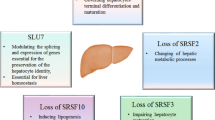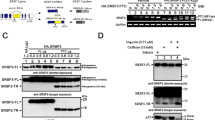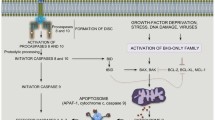Abstract
Ubiquitous free radical production occurs continuously in cells and tissues. Glutathione is the most abundant mammalian antioxidant, and is synthesized by glutathione synthetase (GSS). Therefore, GSS plays an important role in defending the cell against reactive oxygen species. The expression of GSS has been studied in human cells; however, sequence information about alternative splicing variants of GSS mRNA has not been reported. In the present study, we identified a novel alternative splicing variant (ASV) of the GSS gene in 10 human normal tissues and five human cancer cell lines. The deleted transcript of GSS was characterized by an in-frame deletion of 333 bp, corresponding to the complete loss of exons 4 and 5. Thus this GSS ASV causes protein truncation. We quantified the mRNA of GSS ASV in human normal tissues using real-time PCR. The ASV was detected in colon, kidney, lung, liver, placenta, peripheral blood and uterus, but not in heart, skeletal muscle and spleen tissue. Our results provide a basis for more detailed studies on the regulation of GSS, and for further evaluation of this and other possible roles of GSS. Understanding the regulation of GSS expression is very important for the development of new strategies for controlling the development of GSH-based redox homeostasis.



Similar content being viewed by others
Abbreviations
- GSS:
-
Glutathione synthetase
- GSH:
-
Glutathione
- ASV:
-
Alternative splicing variant
- cDNA:
-
Complementary DNA
- RACE:
-
Rapid amplification of cDNA ends
- ROS:
-
Reactive oxygen species
- NMD:
-
Nonsense-mediated mRNA decay
References
Mohler DN, Majerus PW, Minnich V, Hess CE, Garrick MD (1970) Glutathione synthetase deficiency as a cause of hereditary hemolytic disease. N Engl J Med 283:1253–1257
Al-Jishi E, Meyer BF, Rashed MS, Al-Essa M, Al-Hamed MH, Sakati N, Sanjad S, Ozand PT, Kambouris M (1999) Clinical, biochemical, and molecular characterization of patients with glutathione synthetase deficiency. Clin Genet 55(6):444–449
Oort M, Loos JA, Prins HK (1961) Hereditary absence of reduced glutathione in the erythrocytes—a new clinical and biochemical entity? (Preliminary communication). Vox Sang 6:370–373. doi:10.1111/j.1423-0410.1961.tb03178.x
Prins HK, Oort M, Loos JA, Zurcher C, Beckers T (1966) Congenital nonspherocytic hemolytic anemia, associated with glutathione deficiency of the erythrocytes. Hematologic, biochemical and genetic studies. Blood 27:145–166
Spielberg SP, Garrick MD, Corash LM, Butler JB, Tietze F, Rogers L, Schulman JD (1978) Biochemical heterogeneity in glutathione synthetase deficiency. J Clin Invest 61:1417–1420. doi:10.1172/JCI109060
Ristoff E, Mayatepek E, Larsson A (2001) Long-term clinical outcome in patients with glutathione synthetase deficiency. J Pediatr 139:79–84. doi:10.1067/mpd.2001.114480
Beutler E, Gelbart T, Pegelow C (1986) Erythrocyte glutathione synthetase deficiency leads not only to glutathione but also to glutathione-S-transferase deficiency. J Clin Invest 77:38–41. doi:10.1172/JCI112298
Meister A, Anderson ME (1983) Glutathione. Annu Rev Biochem 52:711–760. doi:10.1146/annurev.bi.52.070183.003431
Uhlig S, Wendel A (1992) The physiological consequences of glutathione variations. Life Sci 51:1083–1094. doi:10.1016/0024-3205(92)90509-N
Shi Z-Z, Habib GM, Rhead WJ, Gahl WA, He X, Sazer S, Lieberman MW (1996) Mutations in the glutathione synthetase gene cause 5-oxoprolinuria. Nat Genet 14:361–365. doi:10.1038/ng1196-361
Vives Corrons J-L, Alvarez R, Pujades A, Zarza R, Oliva E, Lasheras G, Callis M, Ribes A, Gelbart T, Beutler E (2001) Hereditary non-spherocytic haemolytic anaemia due to red blood cell glutathione synthetase deficiency in four unrelated patients from Spain: clinical and molecular studies. Br J Haematol 112:475–482. doi:10.1046/j.1365-2141.2001.02526.x
Dahl N, Pigg M, Ristoff E, Gali R, Carlsson B, Mannervik B, Larsson A, Board P (1997) Missense mutations in the human glutathione synthetase gene result in severe metabolic acidosis, 5-oxoprolinuria, hemolytic anemia and neurological dysfunction. Hum Mol Genet 6:1147–1152. doi:10.1093/hmg/6.7.1147
Njalsson R, Ristoff E, Carlsson K, Winkler A, Larsson A, Norgren S (2005) Genotype, enzyme activity, glutathione level, and clinical phenotype in patients with glutathione synthetase deficiency. Hum Genet 116:384–389. doi:10.1007/s00439-005-1255-6
Webb GC, Vaska VL, Gali RR, Ford JH, Board PG (1995) The gene encoding human glutathione synthetase (GSS) maps to the long arm of chromosome 20 at band 11.2. Genomics 30:617–619. doi:10.1006/geno.1995.1287
Belli R, Amerio P, Brunetti L, Orlando G, Toto P, Proietto G, Vacca M, Tulli A (2005) Elevated 8-isoprostane levels in basal cell carcinoma and in UVA irradiated skin. Int J Immunopathol Pharmacol 18:497–502
Schwedhelm E, Boger RH (2003) Application of gas chromatography-mass spectrometry for analysis of isoprostanes: their role in cardiovascular disease. Clin Chem Lab Med 41:1552–1561. doi:10.1515/CCLM.2003.238
Nagao K, Kohno N, Wakita K, Hikiji K, Hirata H, Hisatomi H (2003) Expression of a novel splicing variant deleting exons 4 and 6 of the progesterone receptor gene is a rare event in breast cancer. Oncol Rep 10:305–308
Hanke J, Brett D, Zastrow I, Aydin A, Delbruck S, Lehmann G, Luft F, Reich J, Bork P (1999) Alternative splicing of human genes: more the rule than the exception? Trends Genet 15:389–390. doi:10.1016/S0168-9525(99)01830-2
Mironov AA, Fickett JW, Gelfland MS (1999) Frequent alternative splicing of human genes. Genome Res 9:1288–1293. doi:10.1101/gr.9.12.1288
Stallings-Mann ML, Ludwiczak RL, Klinger KW, Rottman F (1996) Alternative splicing of exon 3 of the human growth hormone receptor is the result of an unusual genetic polymorphism. Proc Natl Acad Sci USA 93:12394–12399. doi:10.1073/pnas.93.22.12394
Liu W, Qian C, Francke U (1997) Silent mutation induces exon skip** of fibrillin-1 gene in Marfan syndrome. Nat Genet 16:328–329. doi:10.1038/ng0897-328
Frischmeyer PA, Dietz HC (1999) Nonsense-mediated mRNA decay in health and disease. Hum Mol Genet 8:1893–1990. doi:10.1093/hmg/8.10.1893
Lykke-Andersen J, Shu MD, Steitz JA (2000) Human Upf proteins target an mRNA for nonsense-mediated decay when bound downstream of a termination codon. Cell 103:1121–1131. doi:10.1016/S0092-8674(00)00214-2
Watakabe A, Tanaka K, Shimura Y (1993) The role of exon sequences in splice site selection. Genes Dev 7:407–418. doi:10.1101/gad.7.3.407
Cartegni L, Krainer AR (2002) Disruption of an SF2/ASF-dependent exonic splicing enhancer in SMN2 causes spinal muscular atrophy in the absence of SMN1. Nat Genet 30:377–384. doi:10.1038/ng854
Liu HX, Cartegni L, Zhang MQ, Krainer AR (2001) A mechanism for exon skip** caused by nonsense or missense mutations in BRCA1 and other genes. Nat Genet 27:55–58
Cartegni L, Wang J, Zhu Z, Zhang MQ, Krainer AR (2003) ESEfinder: a web resource to identify exonic splicing enhancers. Nucleic Acids Res 31:3568–3571. doi:10.1093/nar/gkg616
Smith PJ, Zhang C, Wang J, Chew SL, Zhang MQ, Krainer AR (2006) An increased specificity score matrix for the prediction of SF2/ASF-specific exonic splicing enhancers. Hum Mol Genet 15:2490–2508. doi:10.1093/hmg/ddl171
Acknowledgments
We are indebted to Naoko Shirakawa and Nanae Ishikawa of the 366 Rehabilitation Hospital for their kind assistance in this study.
Author information
Authors and Affiliations
Corresponding author
Additional information
The sequence reported in this paper has been deposited in the GenBank database (accession no. AB459500).
Rights and permissions
About this article
Cite this article
Uchida, M., Sugaya, M., Kanamaru, T. et al. Alternative RNA splicing in expression of the glutathione synthetase gene in human cells. Mol Biol Rep 37, 2105–2109 (2010). https://doi.org/10.1007/s11033-009-9675-3
Received:
Accepted:
Published:
Issue Date:
DOI: https://doi.org/10.1007/s11033-009-9675-3




